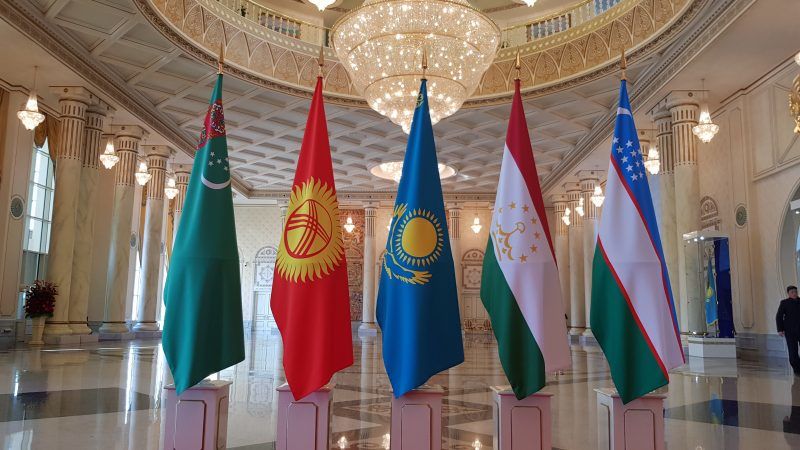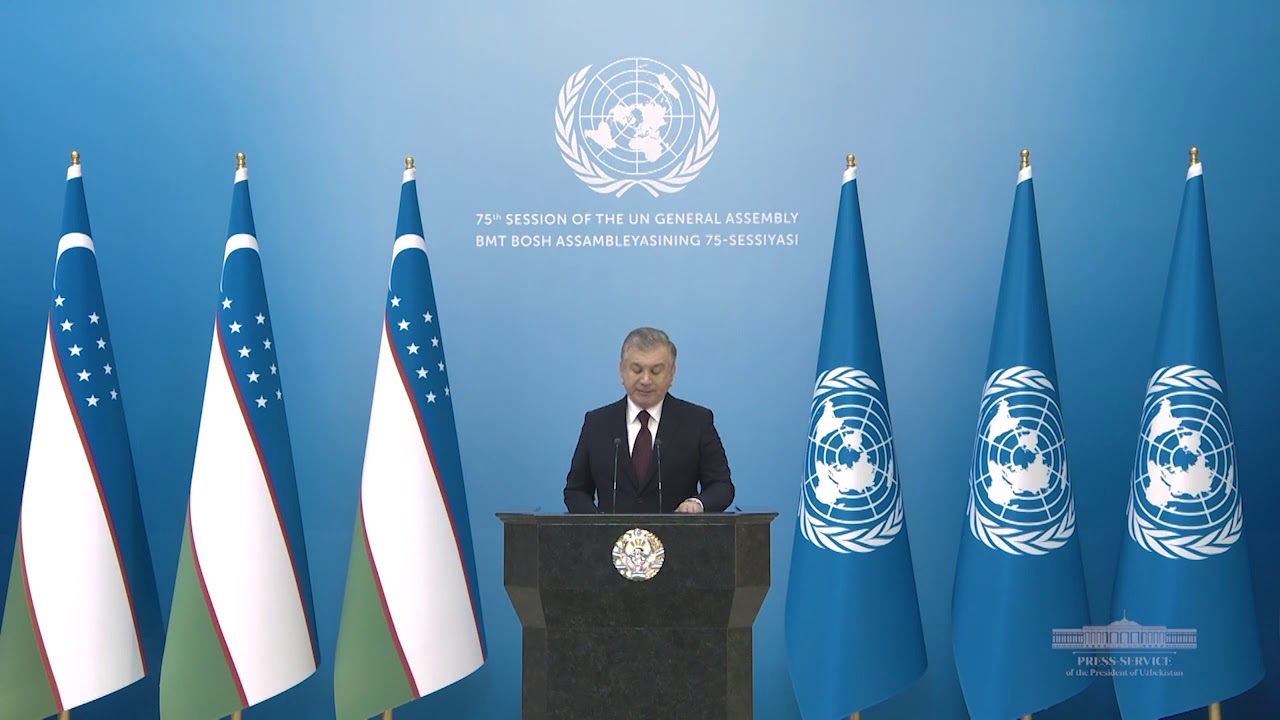With the election of President Shavkat Mirziyoyev, Uzbekistan has embarked on an intense journey to conduct a proactive, pragmatic and constructive foreign policy, which has as its central core, the fostering of mutually beneficial cooperation, stability and sustainable development throughout Central Asia.

(Source: euractiv.com)
This new approach from Tashkent has found support in all capitals of Central Asia, laying down a firm foundation for positive changes in the region.
Over the past several years, there has been a qualitative shift towards strengthening regional cooperation in Central Asia, which has included, but not limited to a systematic political dialogue based on the principles of good-neighborliness, mutual respect and equality which is being established among many of these regional leaders.
This is evidenced by the introduction of the practice of holding regular consultative meetings of the heads of state of Central Asia since 2018.
Another important achievement was the adoption of the Joint Statement of the Leaders of the Central Asian States at the second Consultative Meeting held in November 2019, which should be viewed as a development program for the region. This joint tactic contains consolidated approaches and a common vision of the heads of state regarding the prospects for strengthening regional cooperation.
The high-level consolidation of the region, as well as the willingness of the Central Asian countries to share responsibilities for common regional problems, is also evidenced by a special UN General Assembly resolution: "Strengthening Regional and International Cooperation to Ensure Peace, Stability and Sustainable Development in the Central Asian Region", which was adopted in June 2018.
With the amalgam of these positive trends, the Central Asia states are now finding long-term solutions to a number of systemic problems that previously hindered full realization of the enormous potential of regional cooperation. These solutions are based on mutually-agreeable principles and reasonable compromises, which serve the interests of all involved parties.
Most important, the Central Asian states have begun to play a key role in decision-making on the most urgent and pressing regional development issues.
Such strengthening of inter-state relations today has helped establish Central Asia as a stable, open and dynamically developing region; a reliable and predictable international partner and a large and attractive marketplace with considerable business and leisure travel potential.
This new political atmosphere has given way to a powerful impetus in the development of trade and economic, cultural and humanitarian exchanges. The dynamic growth of trade within the region, which reached $5.2 billion in 2019 - 2.5 times more than that in 2016 - was testament to this phenomenon as intra-regional trade hit $5 billion in 2020 despite the negative effects of the global COVID-19 pandemic.
The region's total foreign trade in the 2016-2019 period jumped 56% to $168.2 billion. During the same period, the FDI inflow to the region increased by 40%, reaching $37.6 billion.
As a result, the share of investments in Central Asia, compared to the total investment volume in the world, surged from 1.6% to 2.5%.
The leisure tourism potential of the region has also dramatically increased with the number of travelers to the Central Asian countries in the four year span from 2016 through 2019, has doubled, jumping from 9.5 million to 18.4 million visitors.
As a result, the region’s overall macroeconomic indicators have significantly improved, with the combined GDP of the regional countries reaching $253 billion in 2016 to a substantial $302.8 billion in 2019. Against the backdrop of the COVID-19 pandemic, it fell by a mere 2.5 percent to $295.1 billion by the end of 2020.

(Source: ebrd.com)
All these factors point to Uzbekistan's successful new pragmatic approaches in its foreign policy have led to the creation of favorable conditions for the Central Asian states to jointly promote major economic projects of trans-regional nature, elevate their relations with neighboring regions to a new level and actively involve the region in multilateral coordination and cooperation structures.
Such plans are enshrined in the above-mentioned joint statement of the heads of state of Central Asia issued at the end of the 2019 Consultative Meeting. In particular, the document notes that the Central Asian states will strive to develop an open economic cooperation model and diversify their relations with other partner countries and international and regional organizations in the hope of consolidating regional peace and stability and improving prospects for economic development in the region.
The concept of economic and political interconnectedness promoted by Uzbekistan is based on a bold vision to build a solid architecture of mutually beneficial cooperation between Central Asia and South Asia that will facilitate the realization of these above-mentioned goals.
The interests of all states in both regions in developing closer relations, a clear understanding of the indivisibility of security, the complementary nature of economies and the interconnectedness of socio-economic development processes in Central and South Asia are further motivations for Tashkent’s aspirations.
The implementation of those plans are aimed at creating a vast space of equal opportunities, mutually beneficial cooperation and sustainable development. They are designed to create a “belt of stability” around Central Asia. Guided by these goals, President of the Republic of Uzbekistan Shavkat Mirziyoyev has put forward a bold initiative to hold an international conference in Tashkent in July 2021 entitled, "Central and South Asia: Regional Connectivity. Challenges and Opportunities", which will bring together the countries of the two regions to design the conceptual foundations of a sustainable model of inter-regional connectivity.
This idea was first put forward in the President’s speech at the 75th Session of the United Nations General Assembly. These issues took center stage in another important political event in 2020 - the President's address to the Parliament, in which South Asia was identified as a priority in Uzbekistan's foreign policy.
(Source: unesco.org)
Concurrently, Uzbekistan significantly increased its political and diplomatic activities in South Asia which can be reflected in its efforts to promote an "India-Central Asia" dialogue, a series of virtual bilateral summits, such as "Uzbekistan-India Summit” held in December 2020 and "Uzbekistan-Pakistan Summit” held in April 2021.
The signing of the Uzbekistan-Afghanistan-Pakistan trilateral agreement was a landmark event as it created a new Trans-Afghan corridor which is designed to connect the countries in these two regions with a reliable transportation network.
These and other steps show that Uzbekistan has started implementing its plans to build a large trans-regional connectivity and “interconnectedness”.
The upcoming high-level conference will be a system-forming element and culmination of these efforts. In this regard, the planned event has already triggered increased interest among a wide spectrum of regional and international experts, who have noted the importance and relevance of the conference.
Additionally, the conference has generated media interest from varied international media outlets, including as:
The Diplomat (US)
Project Syndicate (US)
Modern Diplomacy (EU)
Radio Free Europe (EU/US)
Nezavisimaya Gazeta (Russia)
Anadolu Agency (Turkey), and
Tribune (Pakistan) have commented on the plans of building inter-regional connectivity.
According to analysts’ estimation, the results of the forthcoming conference could be a catalyst to the idea of a grand integration project, potentially bringing rapprochement of the two fast-growing regions from similar cultural backgrounds.
Such a prospect could generate new economic growth poles for Central and South Asia, dramatically transforming the economic landscape of the macro-region and improving inter-regional coordination which in turn ensures stability.
Central Asia Moves Towards a Diversification of Transport and Transit Routes
Strengthening inter-regional ties fulfills the goals of the Central Asian states to diversify transport routes and increase the competitiveness of the region as an international transport and transit hub. During varied summit meetings, leaders of the Central Asian states have repeatedly expressed their shared intention to strengthen coordination and deepen regional cooperation on joint implementation of major economic projects, especially those aimed at expanding transport and transit opportunities, ensuring stable access to ports and world markets and establishing modern international logistics centers.
The challenge to solve these issues is predicated by the constant transport isolation of Central Asia, which prevents a deeper integration of the region into global supply chains and the Central Asian states from gaining their rightful place in the emerging new model of the international trading system.
Therefore, the regional states, currently having no direct access to ports, bear substantial transport and transit costs, which make up no less than 60% of the cost of imported goods. Carriers waste nearly 40% of their time in transporting goods due to imperfect customs procedures and underdeveloped logistics.
For example: the cost of shipping a container to Shanghai from any Central Asian country is five times higher than that of delivering it via Poland or Turkey. In recent years, the Central Asian states have already succeeded in providing access to the ports in Iran, Georgia, Turkey, Azerbaijan and Russia by using various transport corridors, such as the:
Baku-Tbilisi-Kars
Kazakhstan-Turkmenistan-Iran
Uzbekistan-Turkmenistan-Iran, and
Uzbekistan-Kazakhstan-Russia corridors
Among these transit routes, the International North-South Transport Corridor stands out as it currently provides access for Central Asian goods to world markets through Iranian ports. Concurrently, this project is an example of successful connection of Central Asian states with India, the largest economy in South Asia.
In this context, the implementation of the railway project, "Mazar-e-Sharif-Kabul-Peshawar" will help create a new corridor and form an extensive network of rail lines designed to bring the countries of Central and South Asia closer. This trans-regional inter-connectivity concept promoted by Uzbekistan is the realization of the practical implementation which would benefit all states in the region.
(Source: usbekistan.at)
The beneficiaries of these plans will also be the main actors of international trade, such as China, Russia and the European Union, which are interested in having a stable land access to the South Asian market as a viable alternative to maritime trade routes. With this in mind, there is a high probability of internationalization of the Mazar-e-Sharif-Kabul-Peshawar railway project with the possibility of further expansion of prospective parties interested in financing and taking advantage of the transit potential of this corridor.
For this reason, it is clear that Uzbekistan's plans go far beyond the trans-regional agenda, as the above mentioned railroads will become an important part of international transport corridors, linking the European Union, China, Russia and South and Southeast Asian states through the territory of Central Asia.
As a result, the importance of the Central Asian states in transportation are expected to increase significantly, which will guarantee their active participation in the international transit of goods in the future. This will provide them with additional sources of new funding such as ground transportation transit fees.
Another important achievement will be anticipated reduced transport costs.
According to some economic calculations, transporting a container from Tashkent to Karachi, a Pakistani port, will cost between $1,400 to $1,600. It is about half the cost of transportation from Tashkent to the Iranian port - Bandar Abbas, which is between $2,600 to $ 3,000. In addition, thanks to the implementation of the Trans-Afghan corridor project, the Central Asian states will be able to take advantage of the transit potential of two routes leading to the southern seas at once.
There are already existing corridors to the Iranian ports of Chabahar and Bandar Abbas and "Mazar-e-Sharif-Kabul-Peshawar" with provide further access to the Pakistani ports, like Karachi and Gwadar. Such arrangements will contribute to the formation of a more flexible pricing policy between Iran and Pakistan which is expected to reduce export-import costs significantly.
Most important, the diversification of trade routes will have a favorable effect on the macroeconomic situation in Central Asia.
According to the World Bank experts, further removal of geographical barriers to trade with the international community could increase the aggregate GDP of the Central Asian states by at least 15 percent.
A New Model of Trans-Regional Connectivity for Inclusive Economic Growth
The creation of a new architecture of mutually beneficial cooperation between the regions, which the upcoming conference would contribute to, will create the most favorable conditions to significantly increase the level of trans-regional trade and economic exchanges. According to international experts’ estimations, the implementation of the interconnectivity initiative will connect previously isolated Central Asian markets, rich in hydrocarbon and agro-industrial resources, with the growing consumer markets of South Asia and then further throughout the international community.
This is especially necessary given there is significant and yet unrealized potential for cooperation in trade and economic fields, the full utilization of which is hindered by the lack of a reliable transport network and institutional mechanisms of cooperation. In particular, the volume of mutual trade between Central Asian states and South Asian countries has not yet reached $6 billion. It is significantly lower than that of the South Asian region's trade with the outside world, which exceeds $1.4 trillion.
South Asia's total imports have been growing steadily since 2009, reaching $791 billion in 2020. Therefore, South Asia emerges as one of the most important markets for Central Asian countries. With a combined population of 1.9 billion, making up nearly one fourth of the world population, and a GDP of $3.5 trillion, South Asia is the fastest growing region in the world, with economic growth rate of 7.5% per year. In this context, a recent report by the World Bank points to interesting phenomenon. It estimates that, despite the downside effects of the COVID-19 pandemic, South Asia's prospects for economic recovery are improving, with economic growth expected to reach 7.2% in 2021 and 4.4% in 2022.
This is a substantial recovery from the historic low seen in 2020, which indicates that the region is on a recovery trajectory.
Given all these factors, experts note that the Central Asian producers have every chance to seize their niche in the South Asian market to fully realize their export potential.
For example: a recent special report by the United Nations Economic and Social Commission for Asia and the Pacific estimates that the exports by Central Asian states, as a result of increased inter-regional connectivity, will soar 187% compared to 2010, while the exports of South Asian countries will be up more than 130%.
In this regard, it is necessary to highlight a number of areas in which the development of cooperation is in the interests of all Central and South Asian states.
First is the investment arena where the need to increase cooperation finance and investment is dictated by the declining trend in foreign direct investment in developing countries. According to experts at the UN Conference on Trade and Development, the volume of FDI in developing countries declined by 12% in 2020 alone yet such a slight reduction can jeopardize their recovery from the pandemic.
They argue that this assumption is based on the continuing need of Asian countries to attract large amounts of investment to maintain economic growth.
According to the Asian Development Bank, developing countries on the Asian continent need to invest $1.7 trillion each year between 2016 and 2030 just to meet their infrastructure demands. Those countries are currently investing more than $880 billion per annum in infrastructure.
Under such circumstances, active investment cooperation between the states of Central and South Asia, as well as the adoption of collective measures for the progressive improvement of the investment climate of the macro-region, becomes ever more urgent.
Such joint actions could contribute to the transformation of Central and South Asia into a hub for international financial flows.
Second is the agricultural sector which should be considered to be one of the most promising areas for trade and economic cooperation due to the high demand in South Asia for Central Asian food products.
For example: South Asian countries still experience a food products shortage in certain categories and annually import food products worth nearly $30 billion (India $23 billion, Pakistan $5 billion, Afghanistan $900 million and Nepal $250 million).
Specifically, Nepal currently imports 80 percent of the grain it consumes and food import costs have increased by 62 percent in the last five years. Pakistan's food import spending has also increased, up 52.1% in the first six months of 2020 alone.
Third is the energy sector which has born witness to most South Asian states becoming net importers of hydrocarbons. The region is also periodically experiencing severe power shortages. In particular, the economic driver of South Asia, India, is the third largest oil importer in the world and the third largest consumer of electricity (annual consumption - 1.54 trillion kWh).
Every year, India imports energy resources worth $250 billion.
Under such dire challenges, the implementation of large multilateral projects in the energy sector will be prioritized. Thus, the progress in developing the inter-regional energy project "CASA-1000" will not only increase the opportunities for electricity trade between the regions but will also be the first step towards creating a regional electricity market in Central and South Asia.
Furthermore, the development of the TAPI (Turkmenistan-Afghanistan-Pakistan-India) gas pipeline project, designed to become a symbol of peace and good neighborliness, will strengthen the role of Central Asian states in the energy security architecture of the South Asian region.
Fourth is the regional cooperation in the leisure tourism sector which would untap the enormous potential between the two regions in this sector. Uzbekistan's tourism cooperation with South Asian countries is one such important example. In 2019-2020, only 125,000 people visited Uzbekistan from South Asian countries, only 1.5% of the total number of visitors, and the total export of tourism services to the countries in the region amounted to $89 million, 5.5% of the total.
However, outbound tourism from South Asian countries is expected to continue to grow. The UN World Tourism Organization forecasts that the number of Indian tourists, worldwide, will increase 122% to 50 million by 2022, from 23 million in 2019, and their average expenditure will rise to $45 billion by 2022 from $23 billion.
(Source: comps.gograph.com)
The number of tourists from Bangladesh will jump by 2.6 million over the same period and from Sri Lanka by two million.
Central Asian universities, especially medical schools, are becoming attractive to young people from South Asian countries. The growing number of students studying at Central Asian universities is testament to this as in 2020, the number will reach 20,000 students. Such increased interest by South Asian youth in the educational services of Central Asian states can be explained by the high quality of training and relatively low cost of education.
Fifth is the expanding field of education as countries in both regions are interested in further strengthening cooperation in this field. This will significantly improve training methods for highly qualified personnel in both regions, which is necessary for overcoming social inequality and creating a competitive knowledge-based economy.
Most important, strengthening cooperation in science and education can give a powerful impetus to scientific innovations.
After all, it is intellectual resources combined with the latest technology that makes the decisive engine of economic development.
And finally, within this context, it is noteworthy that the volume of the global high technology market today is estimated at $3.5 trillion, which already exceeds the raw materials and energy resources markets as such the concluding area of possible cooperation between Central Asia and South Asia is science and technological innovation.
The implementation of any integration project would be impossible without the formation of a common cultural and humanitarian space that can bring together peoples of the two regions, increase mutual trust and strengthen friendly relations as cooperation in this area contributes to mutual enrichment and interpenetration of cultures, which is a key condition for building and developing sustainable and long-term relations between the two regions in the fields of economy, politics and security.
These goals require significant steps toward intercultural rapprochement.
There are necessary historical prerequisites for this. The cultural ties between the vast sub-region of Central and South Asia are deeply rooted in history as they date back eons to the period of ancient empires. It was then the initial foundations of trade routes were laid; an extensive network of land routes subsequently emerged. In turn, the ancient cities of Central Asia have been the place of intersection of trade routes from China, Europe and India.
It is clear that Uzbekistan President Shavkat Mirziyoyev has a clear strategic vision, that is revival of historical ties with neighboring regions, restoration of ancient caravan routes, including the Great Silk Road, which has long played the role of a conductor of knowledge, innovation and prosperity.
Such developments are in tune with Uzbekistan's regional strategy. After all, historically Central Asia has reached its peak of prosperity, acting as a crossroad of world civilizations and one of the main centers of international trade.
In general, the practical implementation of Uzbekistan's plans for interconnectedness can create a new economic reality in two regions at once, forming the most favorable ground and all necessary conditions for the inclusive economic development of Central and South Asian states, as well as the progressive improvement of the well-being and prosperity of peoples living in these regions.
This unique perspective shows that Uzbekistan's plans for connectivity are of global significance, as improving the macroeconomic situation and strengthening stability in the two densely populated regions of the world would have a very positive impact on international security.
This initiative should be regarded as another reflection of Uzbekistan's aspirations to make its worthy contribution to ensuring and maintaining international peace and sustainable development throughout the international community.
Note: The above contents only represent the views of the author, and do not necessarily represent the views or position of the Taihe Institute.
—————————————————————
ON TIMES WE FOCUS.
Should you have any questions, please contact us at public@taiheglobal.org




